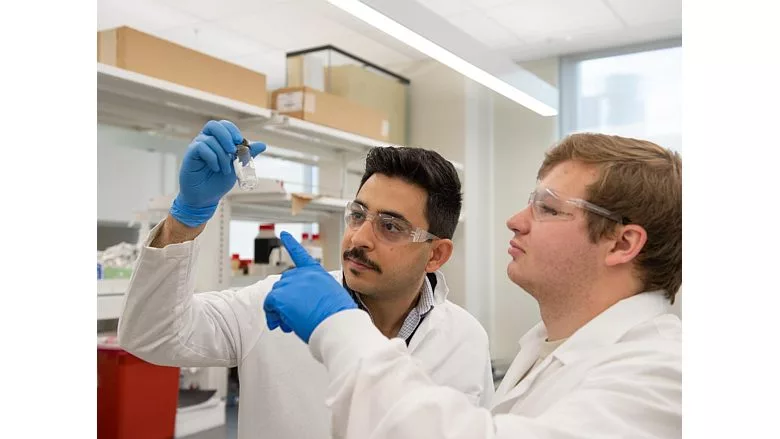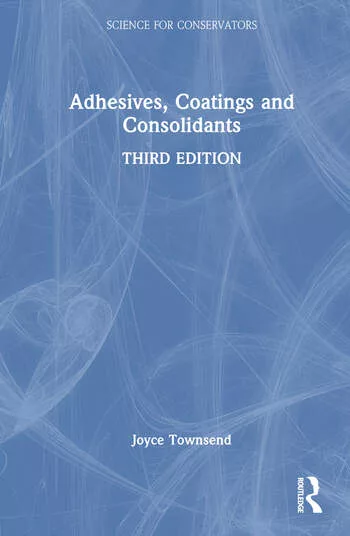Researchers Develop Coating Inspired by Bivalves to Sustainably Extract Rare Earth Elements

Amir Sheikhi (left), assistant professor of chemical engineering and of biomedical engineering and Dawson Alexander, an undergraduate researcher from the Sheikhi Research Group, who was a co-author along with Sheikhi of the paper published in ACS Applied Materials and Interfaces. Courtesy of Sheikhi Research Group.
There is a dilemma surrounding rare earth elements (REE). They play a key role in clean energy - vital to the production of lightweight, efficient batteries, and essential components in wind turbines. However, conventional extraction of these elements raises environmental concerns of habitat destruction and pollution due to the high amount of energy needed to extract and process the elements.
To solve this problem, Penn State researchers found inspiration from the ocean – mussels. Mussels are naturally sticky, and by mimicking this natural glue, researchers developed a new mussel-inspired nanocellulose coating (MINC) that has demonstrated what they call a “remarkable, even surprising” ability to recover REEs from secondary sources such as industrial wastewater without using a high amount of energy.
Mussels have a remarkable ability to adhere to surfaces underwater due to the adhesive properties of catechol-based molecules found in mussel proteins. The MINC mirrors this, consisting of ultra-tiny hairy cellulose nanocrystals with uniquely sticky properties. The MINC is applied to a substrate via a technique called dopamine-mediated ad-layer formation. A chemical reaction enables the MINC to form a thin layer of molecules on a surface, making it capable of sticking to a broad range of substrates.
“The MINC approach offers a sustainable and eco-friendly alternative to conventional extraction methods, minimizing the environmental footprint and contributing to the long-term availability of critical elements,” said lead author Amir Sheikhi, assistant professor of chemical engineering and of biomedical engineering.
The published work focuses on applying MINC to extract a particular REE, neodymium. The United States Department of Energy listed neodymium as a critical material due to supply shortages and its high impact on emerging sustainable technologies. However, the “rare” part of rare earth elements is especially true with neodymium, as the lack of ready-to-extract supply of this element forces extraction of it from secondary sources such as industrial wastewater recycling. This is both inefficient and energy intensive.
“The limited global supply of neodymium and the environmental impact of current extraction methods necessitate the development of eco-friendly and sustainable approaches for REE recovery,” said Sheikhi. Conventional extraction techniques use significant amounts of toxic chemicals, such as kerosene, to purify the target element. The MINC coating is to neodymium what a magnet is to iron, pulling the REE out of water, even when the element is only present in amounts as limited as parts per million.
"The challenge in extracting neodymium lies in achieving efficient and selective removal of it at low concentrations,” said Sheikhi. “The MINC presented in this study offers improved selectivity and capacity for neodymium removal, overcoming limitations of previous methods.”
This selectivity allows MINC to avoid recovering undesired elements like sodium and calcium, which waste time and energy needing to be filtered to refine the neodymium.
“The public and society will benefit from this work through the potential for increased availability of neodymium, a crucial element for not just developing clean energy technologies, but also for creating new medical and electronic devices,” said Sheikhi.
“By providing a sustainable and efficient method for neodymium recovery, this research contributes to the advancement of these technologies and helps address supply shortage concerns, and in turn will increase the possibility of translating this technology to other REE recovery efforts in the future,” said Sheikhi.
Along with Sheikhi, other authors of the paper from the research team include Shang-Lin Yeh, doctoral candidate in chemical engineering; Dawson Alexander, undergraduate student in chemical engineering; Naveen Narasimhalu, undergraduate student in chemical engineering; and Roya Koshani, post-doctoral researcher in chemical engineering. The research was supported by the Energy and Environmental Sustainability Laboratories Green Student Seed Grant program and the Penn State College of Engineering Diefenderfer Graduate Fellowship in Entrepreneurship.
To learn more, visit www.psu.edu/news.
Looking for a reprint of this article?
From high-res PDFs to custom plaques, order your copy today!






